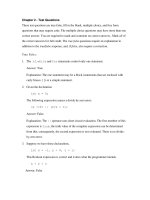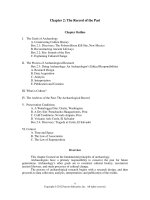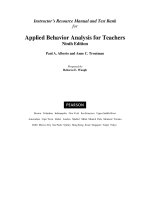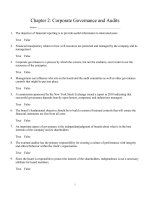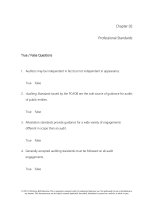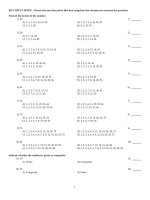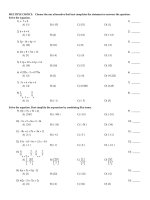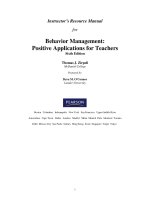Functions modeling change a preparation for calculus 5th edition connally test bank
Bạn đang xem bản rút gọn của tài liệu. Xem và tải ngay bản đầy đủ của tài liệu tại đây (64.37 KB, 9 trang )
Chapter 1 Section 1.1
1. Does the following graph give y as a function of x?
Ans: yes
Learning Objective: Decide whether a given relation is a function.Decide whether a
given relation is a function.Decide whether a given relation is a function.; Recognize
when a relationship between two quantities determines a function and use and interpret
function notation.
difficulty: easy
2. Use the following table to find p (20) . If there is more than one answer, enter the
smallest first and separate them by semicolons.
x
0
10
20
0
20
30
p( x)
Ans: 30
Learning Objective: Use and interpret function notation.
30
40
40
20
difficulty: easy
3. Use the following table to find a such that p (a ) = 4 . If there is more than one answer,
enter the smallest first and separate them by semicolons.
x
0
1
2
0
2
3
p( x)
Ans: 3
Learning Objective: Use and interpret function notation.
3
4
difficulty: easy
4
2
Chapter 1 Section 1.1
4. Let y = p ( x) be defined by the following graph. What is p(0)?
Ans: h
Learning Objective: Represent and interpret functions using words, tables, graphs, and
formulas.; Use and interpret function notation.
difficulty: easy
Page 2
Chapter 1 Section 1.1
5. Let y = p ( x) be defined by the following graph. If p ( x) = g , what is x? If there is
more than one answer, enter the smallest first and separate them by semicolons.
Ans: f
Learning Objective: Represent and interpret functions using words, tables, graphs, and
formulas.; Use and interpret function notation.
difficulty: easy
Page 3
Chapter 1 Section 1.1
6. Let y = p ( x) be defined by the following graph. Is p( f /2) closer to g, h or i?
Ans: h
Learning Objective: Represent and interpret functions using words, tables, graphs, and
formulas.; Use and interpret function notation.
difficulty: medium
Page 4
Chapter 1 Section 1.1
7. Let y = p ( x) be defined by the following graph. Which of the following are true?
A) If p ( x) > 0, then x < b.
B) If p ( x) > 0, then x > b.
C) If p ( x) > i, then x < a.
D) If p ( x) > i, then x > a.
Ans: A, C
Learning Objective: Represent and interpret functions using words,
tables, graphs, and formulas.
difficulty: medium
8. Write the relationship of population, P, as a function of time, t, in years using function
notation. Assume a direct relationship.
A) P = f (t)
B) t = f (P)
C) t = f (1/P)
D) P = f (1/t)
Ans: A
Learning Objective: Use and interpret function notation.
difficulty: easy
9. If you were to draw a graph representing the total amount of concrete, A, used to pour x
square feet of sidewalk, which axis would x be on?
A) horizontal
B) vertical
Ans: A
Learning Objective: Represent and interpret functions using words, tables,
graphs, and formulas.
difficulty: easy
Page 5
Chapter 1 Section 1.1
10. Consider the information in the following table.
s
t
6
–4
3
3
7
1
5
–1
11
0
4
1
12
8
Could t be a function of s?
Ans: yes
Learning Objective: Decide whether a given relation is a function.Decide whether a
given relation is a function.Decide whether a given relation is a function.; Recognize
when a relationship between two quantities determines a function and use and interpret
function notation.
difficulty: medium
11. You are looking at a graph of P, a function of t. Is it possible for the graph to intercept
the P-axis 5 times?
Ans: no
Learning Objective: Decide whether a given relation is a function.
difficulty: medium
12. What could the following graph reasonably represent?
t
A) The average daily temperature of Denver over a one-year time period with t = 0
being July 1.
B) The average daily temperature of Denver over a one-year time period with t = 0
being January 1.
C) The population of Denver between 1900 and 2000 with t = 0 being 1900.
D) The infant mortality rate in Denver between 1900 and 2000 with t = 0 being 1900.
Ans: B
Learning Objective: Represent and interpret functions using words, tables,
graphs, and formulas.
difficulty: medium
Page 6
Chapter 1 Section 1.1
13. Which of the following graphs is mostly likely to represent the resale price of a car
which depreciates steadily until it is worthless?
Ans: VI
Learning Objective: Represent and interpret functions using words, tables, graphs, and
formulas.
difficulty: hard
14. You have $90 to spend on lunches this month. Each day, you can pack a lunch for
about $1.75, or you can buy lunch at the cafeteria for $5.25. Let p be the number of
times you pack a lunch and b be the number of times you buy lunch. The formula for p
in terms of b is given by p = _____ - _____ b. Round answers to 2 decimal places.
Part A: 51.43
Part B: 3.00
Learning Objective: Represent and interpret functions using words, tables, graphs, and
formulas.
difficulty: medium
15.
Find the value of the expression x 2 − 3 xy if x = 3 and y =
1
.
5
Ans: 36
1
or 7
5
5
Learning Objective: Represent and interpret functions using words, tables, graphs, and
formulas.
difficulty: easy
Page 7
Chapter 1 Section 1.1
16. Solve f ( x) = 0 for x using the graph of f ( x) below.
5
y
4
3
2
1
-5
-4
-3
-2
-1
x
1
2
3
4
5
-1
-2
-3
-4
-5
Ans: There is no solution to the equation f ( x) = 0 .
Learning Objective: Represent and interpret functions using words, tables, graphs, and
formulas.; Use and interpret function notation.
difficulty: hard
17. Let f (t ) be the number of students (in thousands) attending MNO college t years
after 2000. Which of the following statements gives the meaning of the expression
f (15) = 13 ?
A) The number of students attending MNO college in the year 2015 is 13,000.
B) The number of students attending MNO college in the year 2000 is 13,000.
C) The number of students attending MNO college in the year 2013 is 15,000.
D) The number of students attending MNO college in the year 2000 is 15,000.
Ans: A
Learning Objective: Represent and interpret functions using words, tables,
graphs, and formulas.
difficulty: medium
Page 8
Chapter 1 Section 1.1
18. The following chart gives the number of students in a class that are a specific height in
inches
height
55 inches
60 inches
65 inches
number of students
4
7
6
a) Is the number of students in each category a function of the height?
b) Is the height in each category a function of the number of students in that category?
Ans: a) yes
b) yes
Learning Objective: Represent and interpret functions using words, tables, graphs, and
formulas.
difficulty: medium
19. The following chart gives the number of students in a class that are a specific height in
inches
height
55 inches
60 inches
65 inches
number of students
5
7
4
a) What is the most common height of students in this class?
b) What is the least common height of students in this class?
Ans: a) 60 inches
b) 75 inches
Learning Objective: Represent and interpret functions using words, tables, graphs, and
formulas.
difficulty: easy
20. A box with volume 180 ft 3 has a square base of side length s ft and a height of h ft.
Write a formula for the height of the box as a function of the side length of the box.
Ans:
180
h= 2
s
Learning Objective: Represent and interpret functions using words, tables, graphs, and
formulas.
difficulty: hard
21. Express this relationship in function notation (that is, y is a function of x is written y =
f(x)).
Calories burned, c, is a function of activity, a.
Ans: c = f(a)
Learning Objective: Use and interpret function notation.
difficulty: easy
Page 9
